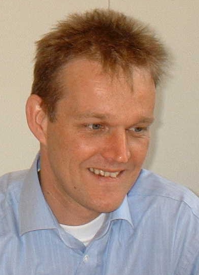Performance Boundaries in Nb3Sn Superconductors
Promotion Date: 15 July 2005
| Niobium-Tin is an interesting superconducting material. The material itself was discovered in 1954 and there is a lot known about it, but for the larger part this knowledge is theoretical and based on idealized, homogeneous samples. Later the applications came, but their characteristics were rather empirically described and their design was mainly based on trial and error. To my view the link between the theory describing idealized samples and the applications is missing. In High Energy Physics applications, Niobium-Titanium is used in the magnets for the accelerators, generating a maximum magnetic field of 10 Tesla. The maximum environmental temperature is 10 Kelvin (at higher temperatures the material loses its superconductivity). |
What was your thesis about?
Niobium-Tin is an interesting superconducting material. The material itself was discovered in 1954 and there is a lot known about it, but for the larger part this knowledge is theoretical and based on idealized, homogeneous samples. Later the applications came, but their characteristics were rather empirically described and their design was mainly based on trial and error. To my view the link between the theory describing idealized samples and the applications is missing.
In High Energy Physics applications, Niobium-Titanium is used in the magnets for the accelerators, generating a maximum magnetic field of 10 Tesla. The maximum environmental temperature is 10 Kelvin (at higher temperatures the material loses its superconductivity). Niobium-Tin on the other hand retains its superconductivity up to approximately 18 Kelvin and 30 Tesla. But it has a problem that Niobium-Titanium does not have: the material is very brittle and its superconducting performance is very sensitive to mechanical loads. So it is a promising, but more difficult material to apply which nonetheless is seen as the successor for Niobium-Titanium in High Energy Physics, fusion technology and other applications where high magnetic fields are necessary.
Part of my research was therefore funded by ITER. In the tokamak of their reactor, which is going to be built in the south of France, in Cadarache, Niobium-Tin will be used. ITER, by the way, will be the first reactor that will probably produce energy and thus reflects significant progress towards a relatively clean nuclear energy source.
I described the properties of Niobium-Tin in circumstances of practical applications, determining to what extent the material still meets the properties it fundamentally has. The core conclusion of my thesis is the determination of the performance loss when actually making a Niobium-Tin wire and how this could be reduced. And that is important, because the performance of Niobium-Titanium is at its maximum, and the recently discovered Magnesium Diboride is still too far from an actual application.
Does that mean that the industry was very interested in your research?
Yes, it is important for the wire manufacturers and applications to know the boundaries of this material.
Did you present your findings?
Yes, I presented my work at various international conferences and at research groups in the US, Europe and Japan. It has also been published in a number of scientific journals.
The way to your promotion has been an extraordinary one. You did not have an
academic qualification when you started your PHD.
That’s right. I did my finals at the HTS (Polytechnical College) in 1992 and started work as a technician here at the university. I got involved in projects dealing with superconductors and the Niobium-Tin wires and in 1997 – 1998 I started to collect my own data purely as a matter of interest. The atmosphere in the group is such that own initiatives are greatly valued. Around 1999 – 2000 this resulted in a PHD research, which in fact was suggested to me earlier, but then I did not feel up to it. I did about two years of my research in the US, in Wisconsin, in a group renowned for its material science research. I was a Research Intern there, meaning that I did not have to go to the lectures but could, for a substantial part, do research on my own account.
What would you like to do next?
As in every research, there are some loose ends which I would like to investigate. And of course the ITER project is very interesting. I could go back to the US. There may be a project here at this University. There are various possibilities.
For the summary of the thesis, click here.

